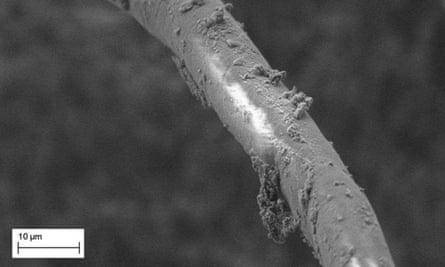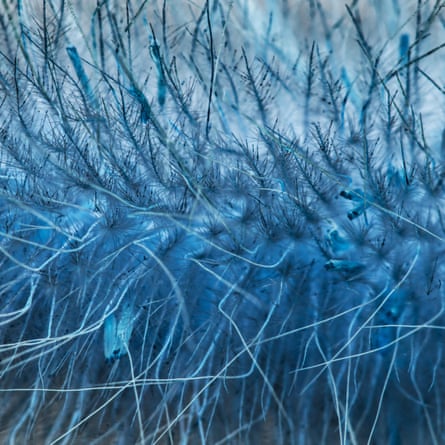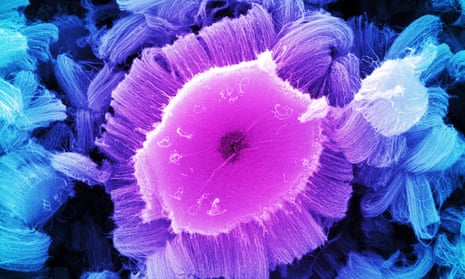In 2019, Ikea announced it had developed curtains that it claimed could “break down common indoor air pollutants”. The secret, it said, was the fabric’s special coating. “What if we could use textiles to clean the air?” asked Ikea’s product developer, Mauricio Affonso, in a promotional video for the “Gunrid” curtains.
After explaining that the coating was a photocatalyst (“similar to photosynthesis, found in nature”), Affonso is shown gazing up at the gauzy curtains while uplifting music plays. “It’s amazing to work on something that can give people the opportunity to live a healthier life at home.”
Puzzled by these claims – how could a mineral coating clean the air? – Avicenn, a French environmental nonprofit organisation, investigated. Independent laboratory tests of the Gunrid textile reported that samples contained tiny particles of titanium dioxide (TiO2) – a substance not normally toxic but which can be possibly carcinogenic if inhaled, and potentially in other forms – which supposedly gives “self-cleaning” properties to things such as paint and windows when exposed to sunlight.

These tiny particles, or nanoparticles, are at the forefront of materials science. Nanoparticles come in all shapes – spheres, cubes, fibres or sheets – but the crucial thing is their size: they are smaller than 100 nanometres (a human hair is approximately 80,000nm thick).
Many nanoparticles exist in nature. Nano-hairs make a gecko’s feet sticky, and nano-proteins make a spider’s silk strong. But they can be manufactured, and because they are so small, they have special properties that make them attractive across a range of endeavours – not just to companies such as Ikea. In medicine, they can transport cancer drugs directly into tumour cells, and nanosilver is used to coat medical breathing tubes and bandages. Nanos could direct pesticides to parts of a plant, or release nutrients from fertilisers in a more controlled manner.
They also have more mundane uses. Synthetic nanos are added to cosmetics and food. Nanosilver is used in textiles, where it is claimed to give antibacterial properties to plasters, gym leggings, yoga mats and period pants.
But scientists such as those at Avicenn are concerned that when these household items get washed, recycled or thrown away, synthetic nanos are released into the environment – making their way into the soil and sea in ways that are still not understood. Some scientists believe nanoparticles could pose an even greater threat than microplastics.
Synthetic nano particles of plastic have been found in the ocean and in ice on both poles. Nanoparticles from socks and sunscreen have been found to pollute water, and certain nanos have been shown to negatively affect marine wildlife including fish and crustaceans. As with antibiotics, resistance to antimicrobial nanosilver can develop – silver-tolerant soil bacteria have now been found.

Little is known even about where nanoparticles are, let alone their effects on the environment. As they are so tiny, most experiments are conducted in labs, and it can be hard to pin down where they are applied.
“The main problem with these substances is that we cannot measure them – we know they are there but they’re so tiny they’re difficult to detect, which is why you don’t hear as much about them,” says Nick Voulvoulis, professor of environmental technology at Imperial College London.
He worries about the uncontrolled use of nanos in consumer products. “If nanos are used properly in applications that are useful or beneficial, that’s justified, but if they are used anywhere and everywhere because they have certain properties, that’s crazy.”
Synthetic nanoparticles are not inherently harmful. Like their natural cousins, many are metal-based, but they can be made of any substance. Crucially, unlike chemical compounds, they cannot be dissolved. Their tiny size gives them, paradoxically, an enormous surface area, which makes them behave differently to “non-nano” versions of the same material. It can make them more mobile, more reactive – and potentially more toxic, depending on shape, size, type, how a substance is released into the environment and its concentration.
And released into the environment they are, on a massive scale. According to Avicenn, the release of nanos is most likely during manufacture or disposal, but it can also happen when items are washed – which is known to occur with fabrics containing nanosilver. Sewage systems cannot trap them and they end up in the ocean: the OECD says even advanced wastewater-treatment plants cannot deal with nanoparticles.
From a health perspective, inhalation is the most harmful route of exposure to nanos such as TiO2 for factory workers and consumers. Avicenn’s tests concluded that the average particle size was 4.9nm, and all 300 particles analysed were below the official nano threshold of 100nm.
Ikea insisted its own tests showed the TiO2 particles were “properly bound to the fabric” and “pose no risk” to customers, and said it took workers’ safety extremely seriously. The firm has not referred to them as nanoparticles, and said that once integrated into textile surfaces there was “no good standard method to measure the particle size distribution of a material”, acknowledging that EU definitions of nanomaterials were under review.
“We recognise that the tests and measurements of nano-particles are complex, especially for materials containing particles that tend to form agglomerates,” it said.
As for Ikea’s curtains shedding TiO2 nanoparticles when washed or discarded, Ikea said it was “confident that the treatment is properly bound to the fabric, and therefore we do not see a risk of inhaling the treatment”, but acknowledged that “as with any textile, parts of the textile can come off during use or washing”.
Many nanos do not persist for long in the environment. However, because they are consistently being discharged, levels remain fairly constant. “Nanos are ‘pseudo-persistent’ because they degrade quite quickly but they keep entering the environment,” Voulvoulis says.
His main concern is whether nanos become carriers for other compounds, a subject of scientific debate. In 2009, Spanish scientists suggested nanos could bind to and transport toxic pollutants, and possibly be toxic themselves by generating reactive free radicals. If other toxic pollutants “latch on” to nanos’ surfaces, they argued, marine plants and animals could absorb them more easily.
Other scientists suggest the opposite: that organic matter in sewage coat nanoparticles, rendering them less active. And others fear nanos could trigger “toxic cocktail” effects – making them more harmful in combination than individual substances would be separately.

So far, synthetic nanomaterials are relatively dispersed in the sea, and unlikely to significantly affect marine animals, says Dr Tobias Lammel of Gothenburg University, who has studied copper nanos. But he warns: “It’s possible that the concentration of some manufactured nanomaterials in the marine environment will increase … It is important to keep an eye on this.”
Given the huge question marks, Avicenn wants more stringent regulations on nanos, and more caution in product design. “Companies are eager to sell innovative and fancy products, but they must thoroughly assess their benefits-risks balance at each step of the life-cycle of the products,” says Mathilde Detcheverry, Avicenn’s policy manager.
From August, the EU will ban use of TiO2 nanos in food (where it is called E171) and the European Commission recently announced that 12 nanomaterials would soon be prohibited in cosmetics.
Detcheverry says: “As scientific knowledge about the environmental and health impacts of engineered nanos such as silver and titanium dioxide advances, we need to make sure nanos are only allowed for specific and essential uses in order to minimise any adverse effects at the source and [ensure they are] not released uncontrollably.”
Two years after the release of Ikea’s Gunrid curtains, Avicenn tried to buy more for further tests, but they had been withdrawn from sale.
Ikea told the Guardian that Gunrid remained “safe to use as a traditional curtain” but it was withdrawn because “the functionality was not as effective as expected”. If that’s true – for example, that despite TiO2 having proven photocatalytic properties and being used in self-cleaning and air-purifying products, its efficacy on curtains could be localised and not powerful – then at the very least Ikea’s experience suggests nanoparticles’ benefits may not outweigh the potential and frequently unknown risks, Detcheverry says.
“Nanoparticles are often promoted as silver bullets against pollution or bacteria,” she says, “but we must make sure that the cure is not worse than the disease.”
Gunrid was just one product of many thousands that use nanoparticles. As Ikea’s Affonso says in the video: “What’s so great about Gunrid is that this technology could be applied to any textile.”
